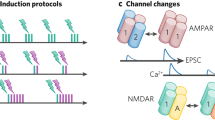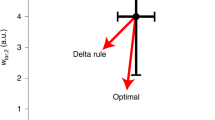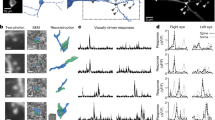Abstract
Synaptic activity drives synaptic rearrangement in the vertebrate nervous system; indeed, this appears to be a main way in which experience shapes neural connectivity1,2. One rearrangement that occurs in many parts of the nervous system during early postnatal life is a competitive process called ‘synapse elimination’3,4. At the neuromuscular junction, where synapse elimination has been analysed in detail, muscle fibres are initially innervated by multiple axons, then all but one are withdrawn and the ‘winner’ enlarges4,5,6. In support of the idea that synapse elimination is activity dependent, it is slowed or speeded when total neuromuscular activity is decreased or increased, respectively4,7,8,9,10,11,12,13. However, most hypotheses about synaptic rearrangement postulate that change depends less on total activity than on the relative activity of the competitors1,2,3,4,13,14. Intuitively, it seems that the input best able to excite its postsynaptic target would be most likely to win the competition, but some theories and results make other predictions14,15,16,17,18. Here we use a genetic method to selectively inhibit neurotransmission from one of two inputs to a single target cell. We show that more powerful inputs are strongly favoured competitors during synapse elimination.
This is a preview of subscription content, access via your institution
Access options
Subscribe to this journal
Receive 51 print issues and online access
$199.00 per year
only $3.90 per issue
Buy this article
- Purchase on SpringerLink
- Instant access to full article PDF
Prices may be subject to local taxes which are calculated during checkout



Similar content being viewed by others
References
Katz, L. C. & Shatz, C. J. Synaptic activity and the construction of cortical circuits. Science 274, 1133–1138 (1996)
Sengpiel, F. & Kind, P. C. The role of activity in development of the visual system. Curr. Biol. 12, R818–R826 (2002)
Lichtman, J. W. & Colman, H. Synapse elimination and indelible memory. Neuron 25, 269–278 (2000)
Personius, K. E. & Balice-Gordon, R. J. Activity-dependent synaptic plasticity: insights from neuromuscular junctions. Neuroscientist 8, 414–422 (2002)
Sanes, J. R. & Lichtman, J. W. Development of the vertebrate neuromuscular junction. Annu. Rev. Neurosci. 22, 389–442 (1999)
Walsh, M. K. & Lichtman, J. W. In vivo time-lapse imaging of synaptic takeover associated with naturally occurring synapse elimination. Neuron 37, 67–73 (2003)
Benoit, P. & Changeux, J. P. Consequences of tenotomy on the evolution of multiinnervation in developing rat soleus muscle. Brain Res. 99, 354–358 (1975)
Thompson, W., Kuffler, D. P. & Jansen, J. K. The effect of prolonged, reversible block of nerve impulses on the elimination of polyneuronal innervation of new-born rat skeletal muscle fibers. Neuroscience 4, 271–281 (1979)
Ding, R., Jansen, J. K., Laing, N. G. & Tonnesen, H. The innervation of skeletal muscles in chickens curarized during early development. J. Neurocytol. 12, 887–919 (1983)
Thompson, W. Synapse elimination in neonatal rat muscle is sensitive to pattern of muscle use. Nature 302, 614–616 (1983)
Duxson, M. J. The effect of postsynaptic block on development of the neuromuscular junction in postnatal rats. J. Neurocytol. 11, 395–408 (1982)
O'Brien, R. A., Ostberg, A. J. & Vrbova, G. Observations on the elimination of polyneuronal innervation in developing mammalian skeletal muscle. J. Physiol. (Lond.) 282, 571–582 (1978)
Busetto, G., Buffelli, M., Tognana, E., Bellico, F. & Cangiano, A. Hebbian mechanisms revealed by electrical stimulation at developing rat neuromuscular junctions. J. Neurosci. 20, 685–695 (2000)
Barber, M. J. & Lichtman, J. W. Activity-driven synapse elimination leads paradoxically to domination by inactive neurons. J. Neurosci. 19, 9975–9985 (1999)
Hata, Y., Tsumoto, T. & Stryker, M. P. Selective pruning of more active afferents when cat visual cortex is pharmacologically inhibited. Neuron 22, 375–381 (1999)
Costanzo, E. M., Barry, J. A. & Ribchester, R. R. Competition at silent synapses in reinnervated skeletal muscle. Nature Neurosci. 3, 694–700 (2000)
Ridge, R. M. & Betz, W. J. The effect of selective, chronic stimulation on motor unit size in developing rat muscle. J. Neurosci. 4, 2614–2620 (1984)
Callaway, E. M., Soha, J. M. & Van Essen, D. C. Competition favouring inactive over active motor neurons during synapse elimination. Nature 328, 422–426 (1987)
Misgeld, T. et al. Roles of neurotransmitter in synapse formation: development of neuromuscular junctions lacking choline acetyltransferase. Neuron 36, 635–648 (2002)
Brandon, E. P., Lin, W., D'Amour, K. A., Pizzo, D. P., Dominguez, B., Sugiura, Y., Thode, S., Ko, C. P., Thal, L. J., Gage, F. H. & Lee, K. F. Aberrant patterning of neuromuscular synapses in choline acetyltransferase-deficient mice. J. Neurosci. 23, 539–549 (2003)
Metzger, D. & Chambon, P. Site- and time-specific gene targeting in the mouse. Methods 24, 71–80 (2001)
Guo, C., Yang, W. & Lobe, C. G. A Cre recombinase transgene with mosaic, widespread tamoxifen-inducible action. Genesis 32, 8–18 (2002)
Feng, G. et al. Imaging neuronal subsets in transgenic mice expressing multiple spectral variants of GFP. Neuron 28, 41–51 (2000)
Lewandoski, M. & Martin, G. R. Cre-mediated chromosome loss in mice. Nature Genet. 17, 223–225 (1997)
Kasthuri, N. & Lichtman, J. W. The role of neuronal identity in synaptic competition. Nature 424, 426–430 (2003)
Keller-Peck, C. R., Walsh, M. K., Gan, W. B., Feng, G., Sanes, J. R. & Lichtman, J. W. Asynchronous synapse elimination in neonatal motor units: studies using GFP transgenic mice. Neuron 31, 381–394 (2001)
Personius, K. E. & Balice-Gordon, R. J. Loss of correlated motor neuron activity during synaptic competition at developing neuromuscular synapses. Neuron 31, 395–408 (2001)
Buffelli, M., Busetto, G., Cangiano, L. & Cangiano, A. Perinatal switch from synchronous to asynchronous activity of motoneurons: link with synapse elimination. Proc. Natl Acad. Sci. USA 99, 13200–13205 (2002)
Lakso, M. et al. Targeted oncogene activation by site-specific recombination in transgenic mice. Proc. Natl Acad. Sci. USA 89, 6232–6236 (1992)
Rodriguez, C. I. et al. High-efficiency deleter mice show that FLPe is an alternative to Cre-loxP. Nature Genet. 25, 139–140 (2000)
Acknowledgements
We thank T. Misgeld and J. Weiner for comments, and R. Lewis for assistance. This work was supported by grants from the National Institutes of Health to J.R.S. and J.W.L.
Author information
Authors and Affiliations
Corresponding author
Ethics declarations
Competing interests
The authors declare that they have no competing financial interests.
Rights and permissions
About this article
Cite this article
Buffelli, M., Burgess, R., Feng, G. et al. Genetic evidence that relative synaptic efficacy biases the outcome of synaptic competition. Nature 424, 430–434 (2003). https://doi.org/10.1038/nature01844
Received:
Accepted:
Issue Date:
DOI: https://doi.org/10.1038/nature01844
This article is cited by
-
Temporal single-cell atlas of non-neuronal retinal cells reveals dynamic, coordinated multicellular responses to central nervous system injury
Nature Immunology (2023)
-
Tumor necrosis factor alpha mediates neuromuscular synapse elimination
Cell Discovery (2020)
-
Terminal Schwann cell and vacant site mediated synapse elimination at developing neuromuscular junctions
Scientific Reports (2019)
-
Mitochondria at the neuronal presynapse in health and disease
Nature Reviews Neuroscience (2018)
-
Tbr1 instructs laminar patterning of retinal ganglion cell dendrites
Nature Neuroscience (2018)



